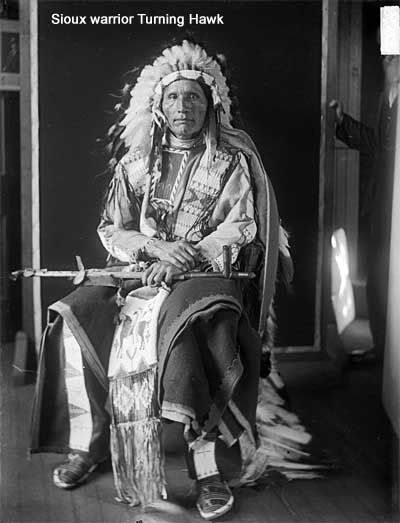|
||||||||||||
Bruce Brown's 100 Voices... Turning Hawk's Story of the Battle
TURNING HAWK'S STORY
TURNING HAWK [came] from north and [at] "4" got along [the] river. Turning Hawk [was almost] killed [at] "5" in Custer massacre, but came alive again. Three [of us] went after Custer [Reno's] horses and two [were] killed, but [the] bullets flying around [at] "5" did not hit Turning Hawk. [There were] three companies. Turning Hawk [was] in party behind army. Turning Hawk killed two Indian scouts [at] "6" -- one Sioux and one Crow. [Note: See The Twisted Saga of the Seventh Cavalry's Unsung Scouts for more info on the Seventh Cavalry scouts killed.] [At] "7" Cheyennes ran Reno from water. Reno tried to cross [the] stream. Turning Hawk [was] not with Sitting Bull. [At] "6" [were enemy scouts] who were trying to run off horses. When so many [soldiers were] killed, Reno tried to get away, but [at] "7" several soldiers dropped in [the] river. Turning Hawk had lots of bullets, and was in [a] Canadian fight one time with Sitting Bull. Turning Hawk shot a cavalryman, and [the] horse fell on [the] cavalryman, and Turning Hawk thought the cavalryman [was] dead. Turning Hawk rushed into [the] middle of the battle [with two others to coup the soldier], and [these] two [others were] shot down. Sitting Bull [was] not in [battle at] "9", but [was] with [others who confronted] Custer. Arapahoes and Cheyennes at "7", and Turning Hawk [was] there. Sitting Bull just [got] back from Crow Reservation when Custer massacre [took place]. Turning Hawk said [he almost] died as four [Indians] rushed into battle and three [were] killed. Turning Hawk ran into [a] soldier in [the] center of battle and [was] knocked off [his] horse which was taken by Crows. [An enemy] Indian [at] "10" then shot at Turning Hawk. Smoke and dust [were] terrible when [at] "10". Turning Hawk threw himself down. [This] man shot [again] at Turning Hawk, and Turning Hawk hit him in [the] hip and breast, killing him. [This enemy scout] happened to be a Sioux named Brush and [he was a] chief. Then [there was] room for Turning Hawk to run out [of the battle]. [Note: more confusion on the number and identies of the Seventh Cavalry scouts killed -- the scout Brush is not listed on Varnum's muster roll. See The Twisted Saga of the Seventh Cavalry's Unsung Scouts for more info.] Lots of soldiers [were] drunk [at] "11" and shot each other. Some smelt [of liquor] after [their] deaths. Turning Hawk got [another] horse and returned to [the] fight, [but by then] only [a] few [soldiers were] left. [Note: click here for more info on American suicides at the Little Bighorn.] Turning Hawk [was] now with Bad Bear and Little Buffalo. One soldier grabbed Little Buffalo [at] "12", [but] Little Buffalo took [his] bridle and struck [the] soldier and took [his] horse. At Custer's last stand [at] "12", Little Buffalo got Custer's horse, a dark sorrel. Custer had short hair and [we] couldn't recognize him. After [the] battle [we] heard Custer had [a] sorrel horse and thought it [was the horse captured at] "12". Lots of Indians knew this sorrel to be Custer's. All soldiers had blue shirts. When all [soldiers had been] killed, [there were] five men with Sitting Bull, and all brought [back captured] horses. One [of these was] Old Bull, [and the] second one [was] Gray Eagle [who] started and returned, [but the names of the] third, fourth, and fifth [men were not remembered by Turning Hawk]. Sitting Bull ordered [the Indians] to stop besieging [Reno Hill] and said, "Let them live -- they are trying to live. They came against us and we have killed a few." (Reno end [of fight.]) Knife King was Sitting Bull's crier at that time. [At] "13" Knife King was announcing [something] when [a] soldier in [a] ditch raised [up] and shot Knife King in [the] body; but Knife King lived. [This happened at] "13" after Reno was driven back [to the timber]. Sitting Bull ordered not to mutilate Custer, and Sitting Bull looked at [the] dead to find him. Then [he] went to next fight at [the] other end. Custer's packhorses and pack mules (wagon train) which followed was attacked [the] next day. After [the] battle Turning Hawk was [enlisted as a] government scout. Indian Views of the Custer Fight: A Source Book by Richard G. Hardorff, The Arthur Clark Co. Spokane, WA 2004, p 143 - 146
A reknowned Hunkpapa warrior, Turning Hawk was also known as Circling Hawk.
|
||||||||||||




 Fort Yates, North Dakota] [June 1930]
Fort Yates, North Dakota] [June 1930]







